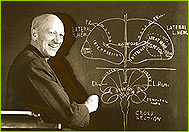Wilder Penfield and his cortical map
 Every neuroscience undergraduate learns about the Penfield map, a correspondence between locations on the stripe across the middle of the top of the brain (somatosensory cortex) to a sequence of locations on the body. This map was discovered by Wilder Penfield in the course of applying electrical stimulation to the brains of hundreds of epilepsy patients he was treating. The size of each area on the map corresponds to the degree of sensitivity we have in that area: areas for the tongue, or the hands, for example, are proportionally larger.
Every neuroscience undergraduate learns about the Penfield map, a correspondence between locations on the stripe across the middle of the top of the brain (somatosensory cortex) to a sequence of locations on the body. This map was discovered by Wilder Penfield in the course of applying electrical stimulation to the brains of hundreds of epilepsy patients he was treating. The size of each area on the map corresponds to the degree of sensitivity we have in that area: areas for the tongue, or the hands, for example, are proportionally larger.
An odd aspect of the map is its placement of the human genitals right next to the feet. This is believed to account for the bizarre phenomenon that people with amputated feet feel orgasms in their phantom foot. It may also lie behind foot fetishes.
My theory is that the Penfield map is related to desirable sitting positions for meditation. In other words, meditation is more effective if body parts which are mapped to nearby brain areas are brought together physically—such as bringing the feet near the genitals in the full-lotus position. The fingers are brought together directly below the eyes, which they are positioned next to on the Penfield map.
Penfield was the exact opposite of a reductionist or physicalist. With his experience in electrical stimulation of the brain, he viewed the key question as: is there any electrical stimulation could make a patient decide or will or believe? His answer was no. He attributed these phenomena not to the brain, but to the “soul”.
Towards the end of his career, Penfield captured his thoughts on the neurological basis for the philosophical belief in the human soul in his book The Mystery of the Mind.
As an aside, Penfield was interested in bilingual children, and felt strongly that early exposure to a second language was highly beneficial to the child’s overall development.

January 16th, 2006 at 11:39
I am looking for an image of Wilder Penfield and an image of his cortical map to use in a Psychology textbook I am working on. Can you advise the source of the image on your website? Thanks…Robyn